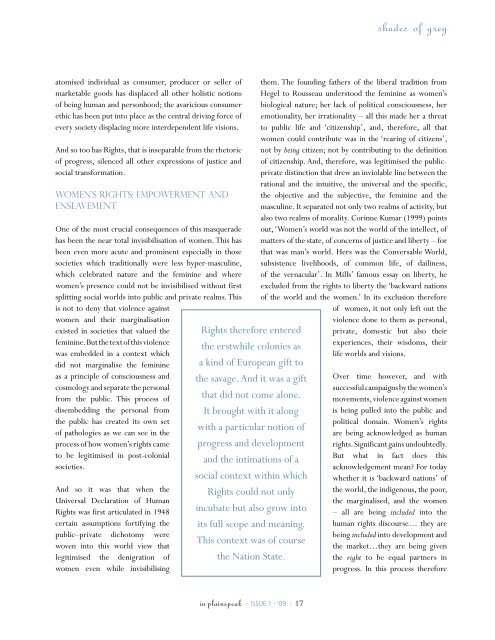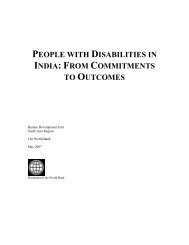Download Pdf - TARSHI
Download Pdf - TARSHI
Download Pdf - TARSHI
Create successful ePaper yourself
Turn your PDF publications into a flip-book with our unique Google optimized e-Paper software.
shades of grey<br />
atomised individual as consumer, producer or seller of<br />
marketable goods has displaced all other holistic notions<br />
of being human and personhood; the avaricious consumer<br />
ethic has been put into place as the central driving force of<br />
every society displacing more interdependent life visions.<br />
And so too has Rights, that is inseparable from the rhetoric<br />
of progress, silenced all other expressions of justice and<br />
social transformation.<br />
Women’s Rights: Empowerment and<br />
Enslavement<br />
One of the most crucial consequences of this masquerade<br />
has been the near total invisibilisation of women. This has<br />
been even more acute and prominent especially in those<br />
societies which traditionally were less hyper-masculine,<br />
which celebrated nature and the feminine and where<br />
women’s presence could not be invisibilised without first<br />
splitting social worlds into public and private realms. This<br />
is not to deny that violence against<br />
women and their marginalisation<br />
existed in societies that valued the<br />
feminine. But the text of this violence<br />
was embedded in a context which<br />
did not marginalise the feminine<br />
as a principle of consciousness and<br />
cosmology and separate the personal<br />
from the public. This process of<br />
disembedding the personal from<br />
the public has created its own set<br />
of pathologies as we can see in the<br />
process of how women’s rights came<br />
to be legitimised in post-colonial<br />
societies.<br />
And so it was that when the<br />
Universal Declaration of Human<br />
Rights was first articulated in 1948<br />
certain assumptions fortifying the<br />
public–private dichotomy were<br />
woven into this world view that<br />
legitimised the denigration of<br />
women even while invisibilising<br />
Rights therefore entered<br />
the erstwhile colonies as<br />
a kind of European gift to<br />
the savage. And it was a gift<br />
that did not come alone.<br />
It brought with it along<br />
with a particular notion of<br />
progress and development<br />
and the intimations of a<br />
social context within which<br />
Rights could not only<br />
incubate but also grow into<br />
its full scope and meaning.<br />
This context was of course<br />
the Nation State.<br />
them. The founding fathers of the liberal tradition from<br />
Hegel to Rousseau understood the feminine as women’s<br />
biological nature; her lack of political consciousness, her<br />
emotionality, her irrationality – all this made her a threat<br />
to public life and ‘citizenship’, and, therefore, all that<br />
women could contribute was in the ‘rearing of citizens’,<br />
not by being citizen; not by contributing to the definition<br />
of citizenship. And, therefore, was legitimised the publicprivate<br />
distinction that drew an inviolable line between the<br />
rational and the intuitive, the universal and the specific,<br />
the objective and the subjective, the feminine and the<br />
masculine. It separated not only two realms of activity, but<br />
also two realms of morality. Corinne Kumar (1999) points<br />
out, ‘Women’s world was not the world of the intellect, of<br />
matters of the state, of concerns of justice and liberty – for<br />
that was man’s world. Hers was the Conversable World,<br />
subsistence livelihoods, of common life, of dailiness,<br />
of the vernacular’. In Mills’ famous essay on liberty, he<br />
excluded from the rights to liberty the ‘backward nations<br />
of the world and the women.’ In its exclusion therefore<br />
of women, it not only left out the<br />
violence done to them as personal,<br />
private, domestic but also their<br />
experiences, their wisdoms, their<br />
life worlds and visions.<br />
Over time however, and with<br />
successful campaigns by the women’s<br />
movements, violence against women<br />
is being pulled into the public and<br />
political domain. Women’s rights<br />
are being acknowledged as human<br />
rights. Significant gains undoubtedly.<br />
But what in fact does this<br />
acknowledgement mean? For today<br />
whether it is ‘backward nations’ of<br />
the world, the indigenous, the poor,<br />
the marginalised, and the women<br />
– all are being included into the<br />
human rights discourse… they are<br />
being included into development and<br />
the market…they are being given<br />
the right to be equal partners in<br />
progress. In this process therefore<br />
in plainspeak · ISSUE 1 · ‘09 · 17










